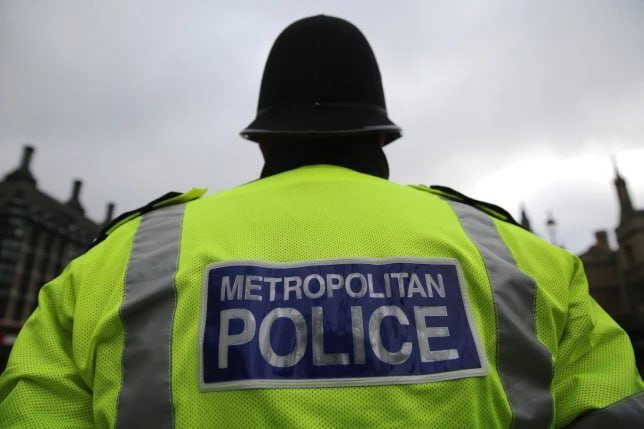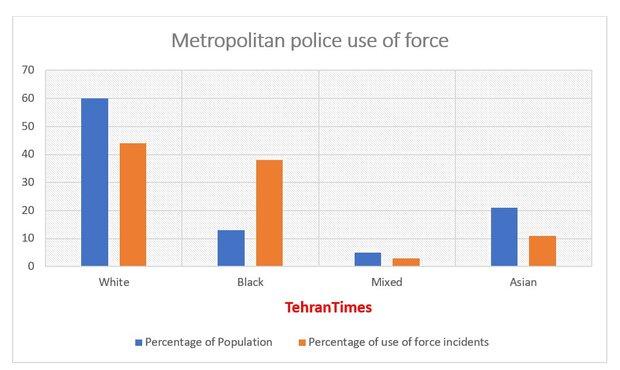Met Police: uniformed criminals

TEHRAN- In every community the police are considered to be the symbol of peace and security. There are few societies in which citizens are afraid of seeing the police, and this is rooted in the name of the police, which comes from the Greek word (polis), which means city and civility.
A police officer is actually a law enforcement officer, but in the modern world, especially in recent years, some policemen's behavior towards citizens has been very harsh in violation of basic human rights.
Hidden violence by police forces in Western countries is far more than developing countries, including those in West Asia and even Africa. This may be related to the complexity of the nature of crime and the definition of criminal behavior as well as the police's view of these countries to humans as useful creature for industrial society.
One of the countries in which police commit lots of violence is Britain. In recent years there has been many news about it.
The name of the British police today is associated with violence, rape, and abuse. With a simple search on the internet, you can find the most harrowing stories of British police that look more like crime books.
Met collection of violence
Some instances of police violence are organized and some others are a result of the spirit of violence among the Metropolitan Police forces.
Today in England, a Metropolitan Police officer, even if he is off-duty, allows himself to handcuff a young girl for not complying with the restrictions of Corona, put her in his car, rape her and kill her!
That girl was none other than Sarah Everard who was killed in March 2021 and the police officer was none other than Wayne Couzens.
Another case in this regard is the case of David Carrick. He is a serving officer in London's Metropolitan Police who has admitted to 49 offenses, including 24 counts of rape over an 18-year period.
David Carrick appeared at Southwark Crown Court in the British capital on Jan 16, 2022 to plead guilty to four counts of rape, false imprisonment, and indecent assault relating to a 40-year-old woman in 2003, the UK’s PA Media news agency reported.
According to CNN, on January 16, 2023, at the Old Bailey criminal court in London last month, Carrick admitted to 43 charges against 11 other women, including 20 counts of rape, between March 2004 and September 2020, according to PA.
A series of recent scandals has shed light on what the UK police watchdog called a culture of misogyny and racism in London’s police service.
The Metropolitan Police Service Commissioner Cressida Dick resigned from her post in 2022, after a damning review by the Independent Office for Police Conduct issued 15 recommendations “to change policing practice” in the country.
London’s Metropolitan Police are now investigating as many as 1,000 sex offenses and domestic abuse claims involving approximately 800 of its officers, the force’s Commissioner Mark Rowley admitted Monday.
“That’s 1,000 cases to look at. Some of those will be things of no concern in the end when we look at them because it will be an argument overheard by neighbors where inquiries show there’s nothing to be concerned about,” Rowley said in an interview with UK media.
An institution ‘in crisis’
Women’s rights organizations called for an inquiry into the Met following Carrick’s case.
UK domestic abuse charity Refuge called Carrick’s crimes “utterly abhorrent.”
“When a man who has been charged with 49 offenses, including 24 charges of rape, is a serving police officer, how can women and girls possibly be – or feel – safe,” Refuge tweeted Monday.
“This is an institution in crisis. That Carrick’s pattern of egregious behavior was known to the Met and they failed to act speaks more loudly than their empty promises to women,” UK organization End Violence Against Women tweeted.
“Solidarity with the victims & all who are feeling the weight of the traumatic details being reported,” it added.
The British Women’s Equality Party tweeted: “The Met knew about the allegations for TWENTY years. They did nothing as a serial rapist abused his power. They are complicit. Misogyny will never be stripped from the police without a nationwide, statutory inquiry.”
The Fawcett Society, which campaigns for gender equality and women’s rights, said on Twitter: “Any act of sexual violence is a disgrace. But it is particularly harmful when, yet again, these crimes have been perpetrated by a person who has additional responsibilities to keep the public safe.”
killing Blacks and Asians
Along with women, the groups that have suffered the most from the British police are the Black people and those with Asian origin.
1,833 people have died in police custody or following police contact in the UK since 1990, British media reported on Sep. 27, 2022.

The killing of Chris Kaba has led to renewed calls for justice as Black people continue to be disproportionately targeted by police violence.
Father-to-be Chris Kaba, 24, was unarmed when he was shot through a car windscreen in Streatham Hill on 5 September 2022 by a Met Police officer.
Metropolitan Police officers are four times more likely to use force against Black people compared with the white population, new figures suggest.
The Met used force 62,000 times in 2017-18 with more than a third of incidents involving Black people.
Techniques such as verbal instructions and using firearms were recorded.
The Met Police said: "The proportionate use of force is essential in some circumstances to protect the public and often themselves from violence."
Shadow home secretary Diane Abbott said the "disproportionate use of force is discriminatory".
Police forces in Britain have been required to keep a detailed record of each time an officer used force since April 1, 2017.
According to the data, a Black person in London is four times more likely than a white person to have force used against them by a Met Police officer, as a proportion of the population.
London's Black population at the last census was 1,088,447. In 2017-18 the Met used force 22,989 times against black people.
Based on population figures, the use of force was equivalent to once for every 50 black people in Greater London and once for every 200 of the white population.
This is higher than in other police forces covering large urban areas such as Greater Manchester and Merseyside.
